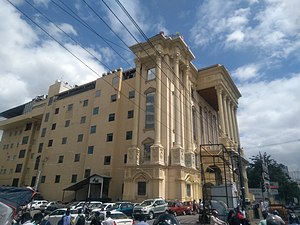Banjara Hills
Banjara Hills is considered the most expensive zip code in India according to Economic Times magazine and along with Jubilee Hills, is the most prestigious borough/city in the greater Hyderabad area to live in. Economic Times estimated that properties in Banjara Hills were worth "a whopping Rs 96,000 crore", an equivalent to US$20.7 billion (As of 8 September 2011).
The much neglected Banjara Lake is also located here.
History

The land was first bought by Nawab Mehdi Nawaz Jung, a minister in the court of the last Nizam in 1927, who built his residence, Banjara Bhavan (supposedly inspired by Antoni Gaudí's works) here. The last Nizam suggested that the area be named after the Nawab, as the man responsible for its development. However, the Nawab stated that it would only be fair to name the area after its original inhabitants, the Banjaras.
The Banjara Bhavan was visited by Jawaharlal Nehru as well as Rabindranath Tagore, who wrote a poem inspired by the area.
Road No. 1 of Banjara Hills is now known as Mehdi Nawaz Jung Road, named in his honour.
Landscape
Banjara Hills is famous for its hotels, upscale restaurants and large shopping malls. Taj Krishna, Taj Deccan, Park Hyatt Hyderabad and Taj Banjara are well-known star hotels in this area. The highest building in the Banjara Hills area is the commercial Laxmi Cyber Centre.
The Jalagam Vengal Rao Park is in Banjara Hills. This park is very beautiful, has its own charm, and many locals visit regularly for jogging and relaxing. Most of the businesses are concentrated on Road No.1 and Road No. 3. Muffakham Jah College of Engineering and Technology is on Road No. 3. This college has one of the largest campuses in the city. It works under the management and ownership of Sultan-ul-Uloom Education Society, which also operates Sultan-ul-Uloom College of Law, College of Education, Junior College, and School in the same premises. KBR park, named after Kasu Brahmananda Reddy, is close to Road No. 3. A cultural centre, called Lamakaan, opened on Road No. 1 in 2010. The 400-year-old, Svayambhu Sri Lakshmi Narasimha Swamy Temple on Road No. 12 is famous for Grand Harinam sankirtans. Guitarmonk school is also there.
Hospitals
Gallery
-
GVK Mall,Banjarahills, Hyderabad
-
Virinchi hospital,Banjarahills, Hyderabad
-
Park Hyatt Hyderabad
-
L. V. Prasad Eye Institute, Banjara Hills
-
PVR Cinemas, Banjara Hills
-
Hyderabad City Center entrance, Banjara hills
-
Hyderabad City Center, Banjara hills
-
x-cite mall at Banjara Hills Hyderabad
-
GVK One Hyderabad
-
Banjara lake
Transport
TSRTC connects Banjara hills to parts of Hyderabad like Dilsukhnagar, Koti, Ghatkesar, and Khairatabad. New flyovers have eased traffic congestion towards this suburb. The closest MMTS train station is at Khairatabad. This suburb has a good road network, with roads being renovated constantly to accommodate high traffic during peak hours.
Localities
Somajiguda, Errammanzil Colony, Srinagar Colony, G.S Colony, Panjagutta and Jubilee Hills are nearby / adjacent areas.
References
- ^ "Check out India's most expensive boulevard". timesofindia-economictimes. Archived from the original on 12 August 2011.
- ^ Luther, Narendra (9 September 2015). "The man who gave Hyderabad its 'Banjara Hills', Nawab Mehdi Nawaz Jung". The News Minute. Retrieved 21 July 2018.
- ^ Venkateshwarlu, K. (16 August 2011). "Another heritage landmark razed". The Hindu.
- ^ Shahid, Sajjad. "Will no one question the 'tyrant'? - Times of India". The Times of India. Retrieved 21 July 2018.
- ^ Kurup, Sonia Krishna. "Roads in Banjara Hills are oddly numbered, not named - Times of India". The Times of India. Retrieved 21 July 2018.









